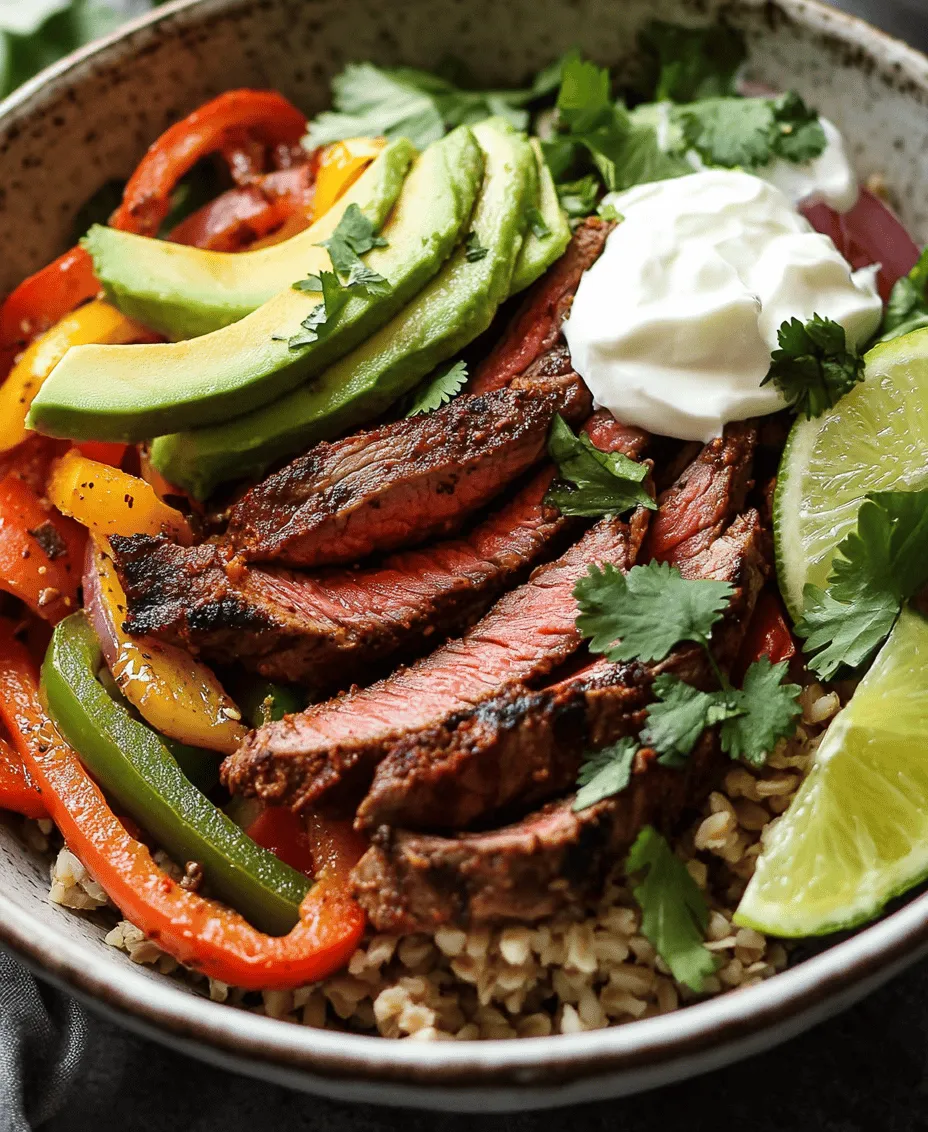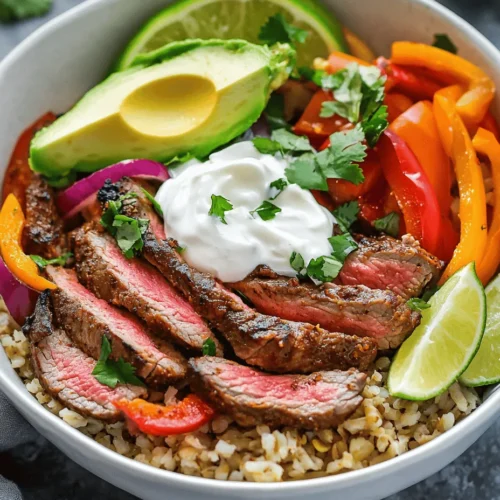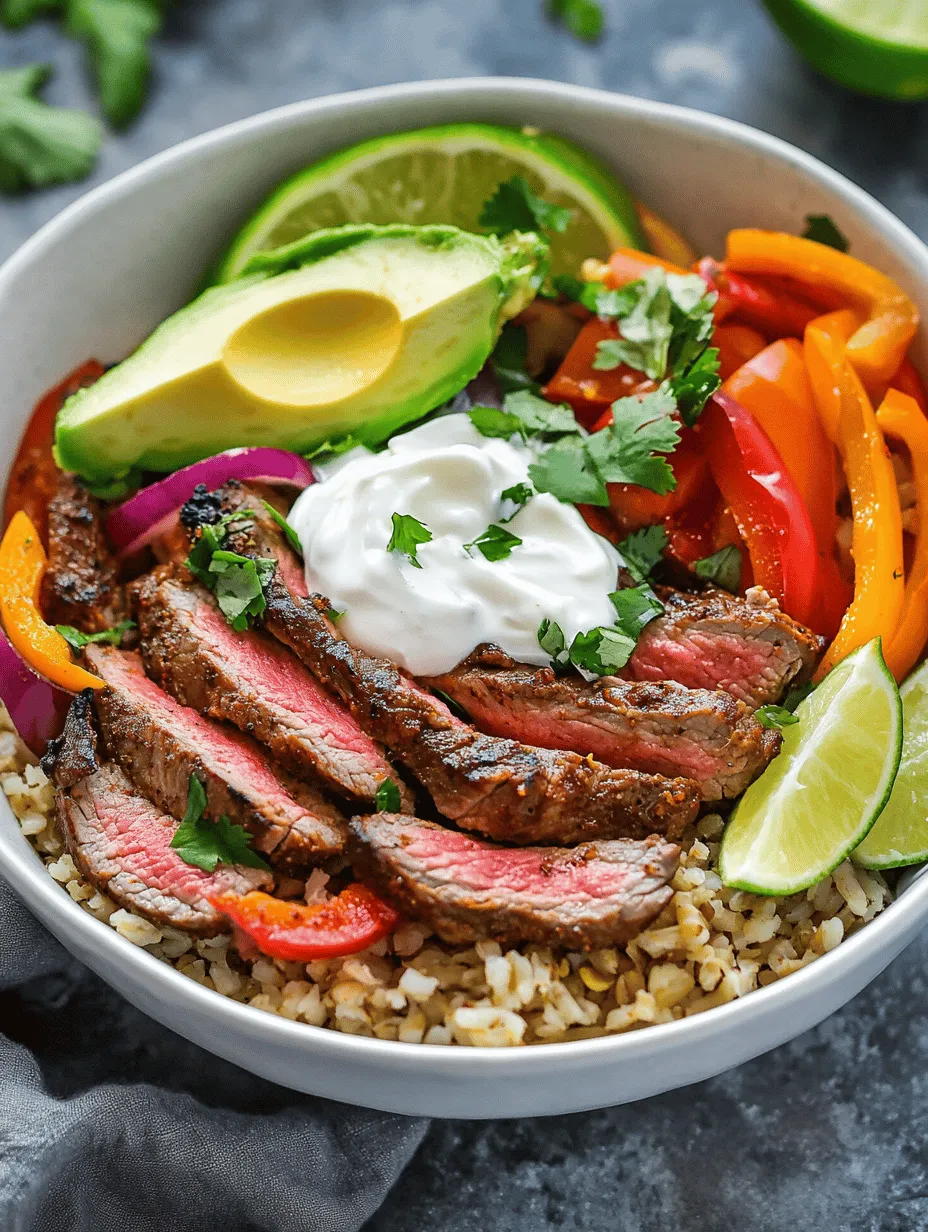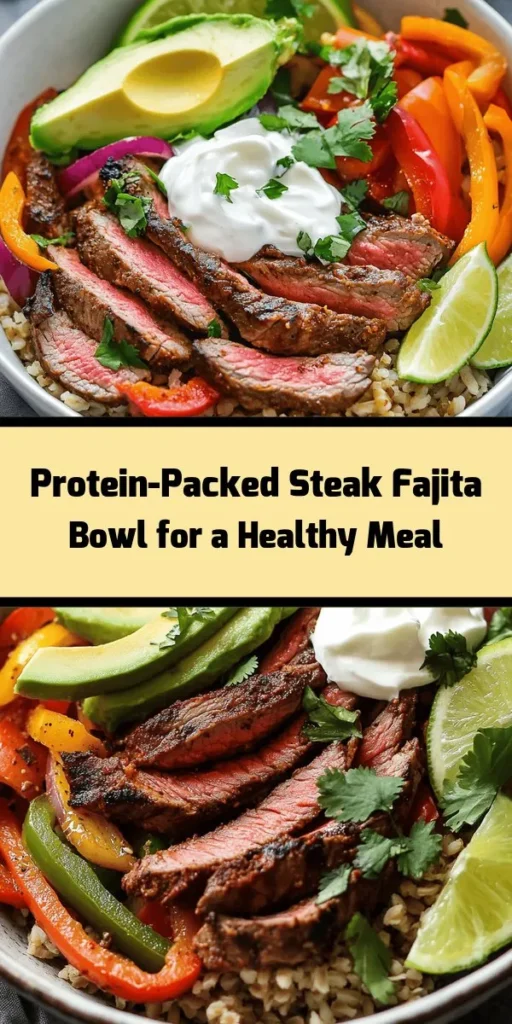Introduction
In recent years, there has been a significant shift towards high-protein meals as more individuals recognize the importance of protein in their diets. High-protein meals are not only known for supporting muscle growth and repair but also for their ability to keep you feeling fuller for longer, making them a popular choice among fitness enthusiasts and health-conscious individuals alike. Among the myriad of high-protein dishes, the steak fajita bowl stands out as a flavorful and satisfying option that packs a nutritional punch.
The high protein steak fajita bowl is a delightful combination of tender, marinated steak, colorful vegetables, and wholesome grains, all topped off with fresh herbs and zesty lime. This dish strikes the perfect balance between protein, fiber, and healthy fats, making it an excellent choice for anyone looking to maintain a nutritious diet without compromising on taste. Whether you’re preparing a quick weeknight dinner or meal prepping for a busy week ahead, this dish is versatile and easy to customize to fit your preferences.
Understanding the Ingredients
Creating a mouthwatering steak fajita bowl starts with understanding the key ingredients that contribute to its taste and nutritional value. Each component plays a critical role in delivering not only flavor but also essential nutrients that support overall health and well-being.
Flank Steak or Sirloin: A Lean Source of Protein
The star of the show in this recipe is undoubtedly the steak. Flank steak and sirloin are both excellent choices, known for being lean cuts of meat that are rich in protein. A standard serving of flank steak offers around 22 grams of protein, making it an ideal option for those looking to increase their protein intake. In addition to being a high-quality protein source, these cuts are also relatively low in fat when trimmed properly, providing a guilt-free indulgence.
Olive Oil: Healthy Fats and Flavor Enhancer
Olive oil serves as the primary fat in the marinade and cooking process, adding depth of flavor while also providing heart-healthy monounsaturated fats. These healthy fats are known to improve cardiovascular health and can help reduce inflammation in the body. Furthermore, olive oil is rich in antioxidants, which can aid in protecting the body from oxidative stress.
Spices: Role of Chili Powder, Cumin, Smoked Paprika, and Garlic Powder in Flavor Development
The flavor profile of the steak fajita bowl is enhanced significantly by the use of spices. Chili powder, cumin, smoked paprika, and garlic powder are essential ingredients that not only add robust flavors but also bring a variety of health benefits.
– Chili Powder: Adds a mild heat and is rich in antioxidants, particularly capsaicin, which has been linked to improved metabolism.
– Cumin: Offers a warm, earthy flavor and is known for its digestive benefits and potential anti-inflammatory properties.
– Smoked Paprika: Provides a unique smoky flavor that elevates the dish and is rich in vitamins A and E.
– Garlic Powder: Adds a savory depth and is celebrated for its immune-boosting properties.
Together, these spices create a deliciously aromatic and flavorful base that complements the steak beautifully.
Vegetables: Nutritional Benefits of Bell Peppers and Red Onions
Bell peppers and red onions are not only colorful additions to the fajita bowl but also provide a wealth of nutrients.
– Bell Peppers: Rich in vitamins A and C, bell peppers are powerful antioxidants that support immune function and skin health. They also contribute fiber to the dish, promoting digestive health.
– Red Onions: These add a sweet and tangy flavor and are high in antioxidants, particularly quercetin, which may help reduce inflammation and lower blood pressure.
Incorporating these vegetables not only enhances the dish’s visual appeal but also boosts its health benefits.
Whole Grains: Importance of Brown Rice or Quinoa in Providing Fiber and Sustenance
To create a hearty and filling meal, pairing the steak and vegetables with whole grains like brown rice or quinoa is essential. Both options are excellent sources of fiber, which aids in digestion and helps maintain steady energy levels.
– Brown Rice: This whole grain is rich in B vitamins and minerals such as magnesium and selenium, promoting overall health and well-being.
– Quinoa: Often regarded as a superfood, quinoa is a complete protein, providing all nine essential amino acids. It’s also gluten-free and packed with fiber and nutrients.
Choosing either brown rice or quinoa not only serves as a satisfying base for the fajita bowl but also adds significant nutritional value.
Black Beans: High Protein and Fiber Content
Adding black beans to the steak fajita bowl is a fantastic way to boost its protein and fiber content. These legumes are an excellent plant-based protein source, making them perfect for those looking to increase their protein intake without relying solely on animal products.
– Protein: A single serving of black beans can provide around 15 grams of protein, making them a powerhouse for muscle repair and growth.
– Fiber: Black beans are also high in dietary fiber, which can help regulate blood sugar levels and promote a healthy digestive system.
Incorporating black beans not only enhances the nutritional profile of the dish but also adds a creamy texture that complements the other ingredients.
Avocado: Healthy Fats and Their Role in Heart Health
No fajita bowl is complete without a generous serving of avocado. This creamy fruit is packed with healthy fats, particularly monounsaturated fats, which are beneficial for heart health. Avocado is also a great source of potassium, which can help regulate blood pressure, and vitamin E, an antioxidant that supports skin health.
Additionally, avocados provide a rich, buttery texture that elevates the overall eating experience, making every bite of the fajita bowl feel indulgent yet nutritious.
Fresh Cilantro and Lime: Flavor Boosters and Their Health Benefits
To finish off the steak fajita bowl, a sprinkle of fresh cilantro and a squeeze of lime juice can make all the difference.
– Cilantro: This fresh herb not only adds a burst of flavor but also provides antioxidants and essential oils that can support detoxification processes in the body.
– Lime: The acidity of lime juice brightens the dish and enhances the flavors of the other ingredients. Lime is also rich in vitamin C, which is essential for immune function and skin health.
Adding cilantro and lime at the end of the preparation process creates a vibrant, refreshing finish that ties all the flavors together beautifully.
Preparation Steps
Now that we’ve explored the nutritional benefits of each ingredient, it’s time to dive into the preparation steps to create the high protein steak fajita bowl. A key aspect of this recipe is the marination process, which is vital for infusing the steak with flavor and ensuring it remains tender during cooking.
Marination Process
1. Choosing the Marinade: The marinade for the steak is a simple yet effective blend of olive oil, spices, and lime juice. The olive oil serves as a base that helps to carry the flavors of the spices into the meat while also providing moisture.
2. Preparing the Marinade: In a mixing bowl, combine olive oil, chili powder, cumin, smoked paprika, garlic powder, salt, and the juice of one lime. Whisk the ingredients together until well combined.
3. Marinating the Steak: Place your flank steak or sirloin in a resealable plastic bag or a shallow dish. Pour the marinade over the steak, ensuring it is evenly coated. Seal the bag or cover the dish and refrigerate for at least 30 minutes. For enhanced flavor and tenderness, consider marinating the steak for up to 4 hours.
Importance of Marinating the Steak for Flavor and Tenderness
Marinating the steak is crucial for two main reasons: flavor enhancement and tenderness. The acids in the marinade, particularly from the lime juice, help to break down the proteins in the meat, resulting in a more tender texture. Additionally, the spices infuse the steak with robust flavors, ensuring that every bite is packed with deliciousness.
Cooking the Steak to Desired Doneness
Once the steak has marinated, it’s time to cook it to perfection. Here are some tips to ensure you achieve your desired level of doneness:
1. Preheat Your Grill or Pan: Whether you choose to grill the steak or cook it in a skillet, preheating the cooking surface is essential for achieving a good sear. A hot grill or pan will create a flavorful crust while keeping the inside juicy.
2. Cooking Time: The cooking time will vary depending on the thickness of the steak and your desired level of doneness. Generally, flank steak will take about 4-5 minutes per side for medium-rare, while sirloin may require slightly longer.
3. Using a Meat Thermometer: For the most accurate results, use a meat thermometer to check the internal temperature of the steak. Aim for 130-135°F for medium-rare, 140-145°F for medium, and 150-155°F for medium-well.
4. Resting the Steak: After cooking, allow the steak to rest for about 5-10 minutes before slicing. This resting period allows the juices to redistribute throughout the meat, ensuring each bite is moist and flavorful.
By following these preparation steps, you’ll be well on your way to creating a delicious and nutritious high protein steak fajita bowl that is sure to impress family and friends alike. The combination of marinated steak, vibrant vegetables, and wholesome grains creates a well-rounded meal that is both satisfying and good for you.

Sautéing Vegetables: Techniques for Achieving the Perfect Char and Tenderness
Sautéing the vegetables for your steak fajita bowl is a critical step that can elevate the dish to new heights. The goal is to achieve a perfect balance of charred edges and tender bites. Start by heating a large skillet or frying pan over medium-high heat—cast iron works exceptionally well for this purpose due to its ability to retain and distribute heat evenly.
Once the pan is hot, add a tablespoon of olive oil to prevent sticking and enhance the flavor. The oil should shimmer but not smoke; if it begins to smoke, reduce the heat slightly.
Next, add your sliced bell peppers and onions to the pan in a single layer, allowing them space to sear. This is essential for developing that much-desired caramelization. Avoid overcrowding the pan, as this can lead to steaming rather than sautéing. Let the vegetables cook undisturbed for a couple of minutes to allow a nice char to form before stirring.
After about 3-4 minutes, when they start to soften and develop color, stir them gently to promote even cooking. Continue to sauté for an additional 2-3 minutes until they reach your desired tenderness. The key here is to pay attention to the timing and adjust the heat as necessary—if you notice the veggies are browning too quickly, lower the heat slightly to avoid burning.
Assembling the Fajita Bowl
Creating the perfect steak fajita bowl is as much about the assembly as it is about the flavors. Follow this step-by-step guide to construct a visually appealing and delicious bowl:
1. Start with the Base: Begin by adding a generous scoop of your chosen base—this could be brown rice, quinoa, or cauliflower rice for a low-carb option. Spread it evenly across the bowl.
2. Layer the Protein: Next, add a portion of your sautéed steak. Make sure to slice it against the grain for maximum tenderness. The warm steak will slightly warm the base, enhancing flavor integration.
3. Add the Vegetables: Top the steak with your sautéed bell peppers and onions. Spread them evenly over the meat to ensure every bite contains a mixture of flavors.
4. Incorporate Additional Ingredients: Now is the time to add any beans (black beans work well), corn, or additional veggies like diced tomatoes or sliced jalapeños. These not only add flavor but also texture and color to your bowl.
5. Garnish with Fresh Elements: Finish the bowl with fresh ingredients like diced avocado, cilantro, or a squeeze of lime. This brightens the dish and adds freshness, balancing the hearty components.
6. Drizzle with Sauce: Finally, consider drizzling your bowl with a sauce or dressing of choice. A dollop of Greek yogurt or a drizzle of homemade vinaigrette can add a creamy element that complements the dish beautifully.
Suggestions for Ingredient Variations
While the traditional steak fajita bowl is delicious as is, feel free to mix things up based on your preferences or dietary needs. Here are some variations you might consider:
– Grain Swap: Replace rice with quinoa for a protein-packed alternative, or use cauliflower rice for a lower-carb version.
– Protein Alternatives: If steak isn’t your preferred protein, consider grilled chicken, shrimp, or even tofu for a plant-based option.
– Vegetable Options: Feel free to experiment with seasonal vegetables such as zucchini, mushrooms, or even sweet potatoes, which can add unique flavors and textures.
Presentation Ideas to Enhance the Dining Experience
Presentation can elevate your meal from simple to spectacular. Here are some tips to enhance the visual appeal of your steak fajita bowl:
– Color Contrast: Use ingredients with varying colors to create a vibrant dish. The bright greens of avocados and cilantro contrast beautifully with the warm shades of the sautéed peppers and steak.
– Layering: Arrange the ingredients in distinct sections rather than mixing them, which allows each component to shine. This not only makes for a more appealing presentation but also helps diners appreciate the individual flavors.
– Serving Dish: Consider using a rustic wooden bowl or a colorful ceramic dish to add character to your presentation.
Nutritional Breakdown
Understanding the nutritional profile of your high protein steak fajita bowl can enhance your meal planning. Here’s a breakdown of what each component contributes:
– Protein Content: A serving of steak provides approximately 25-30 grams of protein, essential for muscle building and repair. This makes the fajita bowl a great post-workout meal.
– Carbohydrates: Depending on whether you choose brown rice, quinoa, or beans, you can expect a healthy serving of carbohydrates, ranging from 30-40 grams. These are crucial for energy, especially if you lead an active lifestyle.
– Healthy Fats: The inclusion of avocado provides healthy fats, including monounsaturated fats that are beneficial for heart health. A tablespoon of olive oil used in sautéing also contributes to your daily fat intake, promoting satiety.
Portion Control and Customization
Portion control is important for maintaining a balanced diet. Customize your fajita bowl based on your specific dietary goals:
– If you are looking to increase protein, add extra steak or beans.
– For a lighter option, reduce the amount of rice or substitute it with more vegetables or greens.
– If you’re focusing on weight loss, consider measuring portions to avoid over-indulgence while still enjoying the flavors you love.
Flavor Pairings and Variations
To further enhance your steak fajita bowl, consider these suggestions for additional toppings and sides:
– Toppings: Fresh salsa, pico de gallo, or a spicy chipotle sauce can add an extra layer of flavor. A sprinkle of cheese can also be a delightful addition.
– Sauces: A drizzle of hot sauce or a tangy vinaigrette can bring a zesty kick to the dish. You might also consider a creamy dressing made from Greek yogurt mixed with lime juice and herbs.
– Alternative Proteins: If you want to switch things up, grilled chicken, shrimp, or marinated tofu can be excellent substitutes for the steak, catering to various dietary preferences.
– Seasonal Variations: Adapt the recipe based on seasonal vegetables or ingredients that you have on hand. For example, roasted butternut squash in the fall or fresh corn in the summer can provide a seasonal twist.
Conclusion
The high protein steak fajita bowl is not only a feast for the eyes but also a powerhouse of nutrition and flavor. Rich in protein, healthy fats, and carbohydrates, it’s an ideal meal for anyone looking to balance their diet while enjoying delicious food.
By experimenting with different ingredients and presentation styles, you can make this dish a staple in your meal planning, tailoring it to your preferences and seasonal availability. Combining flavor with nutrition is key to a satisfying meal experience, and this steak fajita bowl does just that. So, gather your ingredients, follow the steps, and enjoy this delightful and wholesome dish that promises to satisfy both your taste buds and your nutritional needs.



